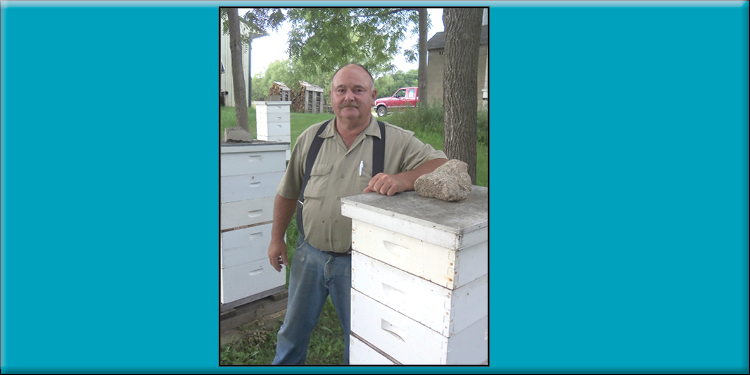by Dennis Dalman
When Conrad Legatt was in high school he wrote a term paper about honey bees and found them to be very interesting. Then, he forgot all about them.
He couldn’t have known then that he would be named Minnesota BeeKeeper of the Year for 2014 by the Minnesota Honey Producers’ Association. Legatt recently received the honor at a banquet at the Kelly Inn in St. Cloud.
“Well, I knew I was going to get it because I happened to walk through the room earlier and saw my name written on a cake,” Legatt said. “It was good to get it, but I know more deserving people.”
After attending vocational school and being drafted for a tour of duty in the U.S. Army, Legatt returned to his home in rural St. Stephen and continued with his life. One day, in the mid-1970s, he was thumbing through a farm-and-ranch catalog from Sears and Roebuck when he noticed there were bee-keeping supplies for sale.
On a kind of whim, he decided to order some bee boxes, odds and ends of equipment and one package of bees. He wasn’t sure what he was doing, but it wasn’t long before he met Clarence Nothnagel of St. Cloud, a retired bee inspector who had started a group called the Tri-County Beekeepers for people in Stearns, Benton and Sherburne counties. Nothnagel invited Legatt to join.
“That’s when I really learned a lot,” he said.
That was more than 30 years ago, and ever since then Legatt has enjoyed his bee hobby. He now has 50 colonies of bees that are kept in groups of white boxes at various places spread throughout his property southwest of St. Stephen. The stacks of boxes (hives) can range from one box to six stacked boxes. The number of honey bees in each box can vary from 40,000 to 60,000 busy bees.
Although beekeepers’ methods vary, the following is an overview of how Legatt raises bees:
Frames
Inside each white box is placed a series of 100 wooden frames that look like rectangular picture frames. Each frame holds a sheet of beeswax on which the bees form their hexagonal (six-sided) honey cells.
When Legatt starts a box, he buys two or three pounds of bees from bee brokers, then puts them in the boxes and feeds them fructose or sugar-water solution until they can make their own food – the honey.
Queen
In a hive of bees there is only one queen, which gets pampered from Day 1 even before it’s born. Worker bees feed her special foods, like royal jelly. As she gets plump and lazy, secure in her prized place in the hive, she begins to lay eggs as soon as the days in February start to grow longer. The queen can lay up to 2,000 eggs at a time. She can lay eggs for up to five years, but generally her bees will replace her after about two years by kicking her out of the hive. A new queen is created when the other bees determine which larva will be singled out as special. That larva will be fed a high-protein concentration of royal jelly that will quickly develop the reproductive organs. After only 16 days of royal feedings, the bee emerges as a queen. She lives in a cell that is vertical, shaped kind of like a peanut whereas all the other bees live in horizontal cells.
Other bees
Once the bee eggs hatch, they are in their larval stage, each with its own hexagonal cell, and the older honey bees feed the larvae with pollen and nectar until, about 21 days after their egg stage, they begin to hatch and emerge from their cells.
Nurse bees are the ones who feed the larvae and do the housekeeping. Sentinel bees guard the hive. Other bees fly off to gather the nectar and pollen from plants far and wide. As they do so, feeding on flowers and plants, they unwittingly pollinate plants by spreading traces of pollen that fertilize other plants they land on. That pollination process is why bees are so vital for so much of the human food supply.
Honey
After nectar and pollen is brought back to the hives by the bees, they add enzymes to them, which makes the rich, sticky honey in the hexagonal cells.
Drone bees are male bees whose only purpose is to mate with virgin queens. They are fed by workers, but after mating the drones are forced out of the hive and they quickly die.
Winter
Contrary to popular belief, honey bees do not hibernate in winter, Legatt noted.
Instead, they form a cluster around the wooden frames, consume stored honey and generate heat from the tiny muscle movements. They all work together moving inside and then outside of their clusters, circulating so the heat is kept in the cluster. The bees can regulate the temperature of their clusters just like a finely-tuned thermostat.
Spring to summer
As the days get warmer, the availability of pollen and nectar multiplies. At first, the bees go for pussy-willow pollen. Later red maples and elms leaf out, as well as dandelions, clover and basswood. Throughout the spring and summer months the bees have a field day as plants and flowers start to bloom. The bee colonies thrive and keep building up in numbers until the end of June. After that, more and more nectar is brought to the hive and is placed in surplus storage in the honeycomb cells.
Fall
Fall is the time beekeepers check for mites and treat for that, if necessary. They also check to see if enough pollen is stored and any other needs. Beekeepers can supplement the stored food supply if there is not enough.
As winter approaches, the bees prepare for their long dormancy, utterly dependent on their stored food to survive the cold weather.
Honey production
In a good year, Legatt harvests about 4,000 pounds of honey, which he markets from his home or sells at the county fairs.
“I’ve enjoyed working with bees,” he said. “When I was working for Viking Industries (furniture-maker in St. Stephen), my beekeeping was a good way to come home from work and relax doing something else.”
Of course, Legatt is used to the standard question: “Do you ever get stung?”
Yes, he does. He’s been stung hundreds if not thousands of times. But normally, honey bees are fairly docile. If while working at the hives he gets stung more than three or four times at a session, he will put his bee suit and bee hat on, even though they are very uncomfortable on warm days.
Bees in danger?
Like many beekeepers, Legatt ponders the fate of honey bees in the modern world.
Their numbers, he said, are diminishing, but nobody is absolutely certain as to why, though it is probably a combination of the following: less vegetation and open areas as the human population expands, mite parasites, a stressful virus and pesticides.
Legatt recommends people who use pesticides should apply them just before dark when the bees have started heading back to their hives. That will prevent the bees from coming into contact with the poison when it is at its most lethal potential.
Family
Born and raised in St. Stephen, Legatt has spent almost all of his life there. He and his wife, Kathy, have five grown children.
photo by Dennis Dalman
Minnesota Beekeeper of the Year Conrad Legatt stands by one of his many bee-hive boxes at his home in rural St. Stephen.
photo by Dennis Dalman
Conrad Legatt shows one of the many frames in his bee boxes. The bees store honey in the hexagonal cells they create in each box. Then the bees cap the cells with beeswax to protect their precious supply of honey.
photo by Dennis Dalman
This is a close-up of the hive frame, clearly showing the hexagonal honey cells made by the bees.
photo by Dennis Dalman
These hive boxes are just some of the 50 honey bee colonies on Conrad Legatt’s country property.
photo by Dennis Dalman
Conrad Legatt holds the wooden plaque he was presented as 2014 Minnesota Beekeeper of the Year from the Minnesota Honey Producers’ Association.
photo by Dennis Dalman
These batches of honey are known as “comb honey.” Some customers prefer to buy honey still in the hexagonal cells covered with beeswax so Legatt, using a hot knife, cuts the sections out of a honey-hive frame to sell them in the blocks pictured above.



















